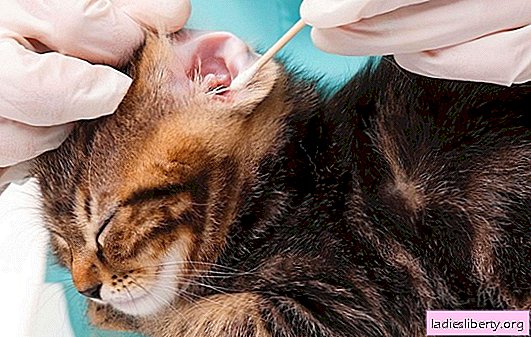
Does the cat constantly scratch its ear, look miserable, and has the earwax turned brown and smelling bad? You may suspect that your ear mites have attacked your pet. This is an unpleasant problem. Where does the ear tick come from in pets and how to cure it? We understand in today's article.
Ear mite in domestic cats: what is it?
Ear mites are extremely small parasitic mites, also known as “otodectes cynotis,” which infect delicate cat ears. These parasites survive by eating your pet's tissues and blood. They can also occasionally live on cat's feet and hair. This allows them to spread to other cats and dogs. They are harmless to humans, but they can use us as a transshipment point - until a cat or dog turns up, which becomes a source of food.
Ear mite in domestic cats: causes
Ear tick infection accounts for more than half of all cat ear infections. This is a very common problem. Ear mites easily attack your pet with:
· Contact with another infected pet (dog or cat)
· Contact with a toy or bed of another infected pet (dog or cat).
· Contact with a person who is a carrier of ear mites (for example, if he has recently been in contact with an infected animal and the mites could remain on shoes or clothing).
· Lack of proper hygiene after contact with an infected animal (thorough cleaning of the ears and taking a bath are necessary).
Ear mite in domestic cats: symptoms
You may suspect the presence of an ear tick in your pet if you notice the following symptoms:
· The cat constantly scratches its ears.
· In and around the ears, hair is actively falling out.
· Brown discharge from the ears, similar to coffee grounds.
Strong odor from ears.
· Inflammatory process.
· The cat shakes its head.
· Scratches and redness inside the ear.
However, symptoms may vary and vary depending on the degree of damage to the ear mites and the duration of the disease. In most cases, an ear tick infection causes only scratching of the ears and dark waxy discharge.
· Some cats are extremely sensitive to any infection, and they can have a more intense response, even with minimal damage. Such cats often have symptoms, which include constant shaking of the head, severe painful scratches of the ears, their constant combing. Ears can also tilt down or to the side. Over time, scratches will lead to hair loss around the ears and even the formation of ear bruises.
Other cats may have serious ear mite lesions, which are almost asymptomatic. But even without visible symptoms, one still gives out problems - brown discharge and a large accumulation of earwax. Excess discharge is due to the impact of ear mites on the inner surface of the ears. Since the movement of parasites irritates the sensitive skin inside the ear, it tries to protect itself with the help of secretion.
Inaction regarding the treatment of ear mites can cause secondary ear infections - skin and bacterial. Most of them arise as a result of permanent trauma to the ear and infection. In such cases, the symptoms will be unpleasant odor, bloody discharge, redness and inflammation of the ears.
Ear mite in domestic cats: diagnosis
If you notice disturbing symptoms, you should immediately contact your veterinarian. Self-diagnosis may be erroneous. Some forces of bacterial infection have similar symptoms and can be mistaken for damage by ear mites. And the treatment for these two problems is completely different. When diagnosing, the veterinarian will first assess the general health status of the pet and conduct a survey. This will help determine if the symptoms may be caused by any kind of hereditary ear disease. At this stage, it is important to inform the veterinarian if the cat has had any interaction with infected or unfamiliar stray cats and dogs. Then the doctor will take an ear swab for analysis, which will be examined under a microscope. This is necessary to make an accurate diagnosis: an ear tick, a bacterial infection, or something else.
Ear mite in domestic cats: treatment
When a cat becomes infected with ear mites, they quickly begin to breed, rapidly increasing their number in the cat's ears. The entire life cycle of ear mites, from hatching eggs to maturation in an adult parasite, takes only three weeks. Immediate treatment is required to prevent the occurrence of permanent damage and relieve the cat of intense itching that causes the tick. The good news is that there are several treatments for ear mites, all of which are light and non-invasive. Depending on the veterinarian’s guidance, treatment may look like any of the following options:
· External medications. Most often, the doctor prescribes medications that are used directly in the ear and in the areas around it. These drugs completely destroy ear mites. Treatment lasts about 3 weeks.
· Medicines against infection. Veterinarians often prescribe ear drops or antibiotic treatment to get rid of any infections that the cat may suffer from. The duration of treatment may vary, but usually it does not exceed one month.
Ear mites easily spread to other cats and dogs. If you have several pets, you should treat all ear mites for ear mites right away, even if one of them has symptoms. Otherwise, ticks can continue to multiply, skip from one pet to another and re-infect them.
Ear mite in domestic cats: prevention
So, we know everything about the identification and treatment of ear mites, but what most people want to know is whether their occurrence can be prevented. To prevent infection by ear mites, it is important to regularly clean your pet’s ears, inspect them, and closely monitor their behavior. It is also necessary to prevent your cat from communicating with yard animals, which can be carriers of ear mites.











